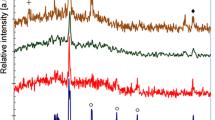Abstract
To reduce the amount of chalcogen needed in the post-annealing process, we demonstrate significantly increased sulfur incorporation into pure sulfide CZTS films achieved by increasing the thiourea content of DMSO-based precursor solution. The increase of sulfur content was confirmed by thermogravimetric analyses (TGA). To understand how the elemental distribution across the CZTS layer is affected by extra thiourea, a systematic compositional study was carried out using X-ray photoelectron spectroscopy (XPS). XPS depth profiling reveals increased sulfur incorporation in the final CZTS films when more thiourea is added to the solution. The grain size was reduced slightly with increased sulfur content and the surface morphology was changed significantly. The effect on the surface of the CZTS film has been investigated using scanning electron microscopy (SEM), Raman spectroscopy, and XPS. External-quantum-efficiency (EQE) measurements with an electrolyte contact were used to investigate the optoelectronic properties of the deposited CZTS films.
Similar content being viewed by others
References
Solar Frontier Achieves World Record Thin-Film Solar Cell Efficiency: 22.3% (2015). Avaliable at: http://www.solar-frontier.com/eng/news/2015/C051171.html (accessed on 13 January 2016).
First Solar Builds The Highest Efficiency Thin Film PV Cell On Record (2014).Avaliable at: http://investor.firstsolar.com/releasedetail.cfm?ReleaseID=864426 (accessed on 14 January 2016).
W. Wang, M. T. Winkler, O. Gunawan, T. Gokmen, T. K. Todorov, Y. Zhu, and D. B. Mitzi, “Device Characteristics of CZTSSe Thin-Film Solar Cells with 12.6% Efficiency,” Advanced Energy Materials, vol. 4, pp. n/a-n/a, 2014.
S. G. Haass, M. Diethelm, M. Werner, B. Bissig, Y. E. Romanyuk, and A. N. Tiwari, “11.2% Efficient Solution Processed Kesterite Solar Cell with a Low Voltage Deficit,” Advanced Energy Materials, pp. n/a-n/a, 2015.
T. Schnabel, T. Abzieher, T. M. Friedlmeier, and E. Ahlswede, “Solution-Based Preparation of Cu2ZnSn(S,Se)4 for Solar Cells - Comparison of SnSe2 and Elemental Se as Chalcogen Source,” Photovoltaics, IEEE Journal of, vol. 5, pp. 670–675, 2015.
H. Xin, S. M. Vorpahl, A. D. Collord, I. L. Braly, A. R. Uhl, B. W. Krueger,D.S.Ginger and H.W. Hillhouse"Lithium-doping inverts the nanoscale electric field at the grain boundaries in Cu2ZnSn(S,Se)4 and increases photovoltaic efficiency,” Physical Chemistry Chemical Physics, 2015.
F. Jiang, S. Ikeda, Z. Tang, T. Minemoto, W. Septina, T. Harada and M. Matsumura"Impact of alloying duration of an electrodeposited Cu/Sn/Zn metallic stack on properties of Cu2ZnSnS4 absorbers for thin-film solar cells,” Progress in Photovoltaics: Research and Applications, pp. n/a-n/a, 2015.
K. Woo, Y. Kim, and J. Moon, “A non-toxic, solution-processed, earth abundant absorbing layer for thin-film solar cells,” Energy & Environmental Science, vol. 5, pp. 5340–5345, 2012
S. Oueslati, G. Brammertz, M. Buffière, H. ElAnzeery, O. Touayar, C. Köble, J. Bekaert, M. Meuris, and J. Poortmans"Physical and electrical characterization of high-performance Cu2ZnSnSe4 based thin film solar cells,” Thin Solid Films, vol. 582, pp. 224–228, 5/1/ 2015.
M. Werner, D. Keller, S. G. Haass, C. Gretener, B. Bissig, P. Fuchs,F. L. Mattina, R. Erni, Y. E. Romanyukm and A. N. Tiwari “Enhanced Carrier Collection from CdS Passivated Grains in Solution-Processed Cu2ZnSn(S,Se)4 Solar Cells,” ACS Applied Materials & Interfaces, vol. 7, pp. 12141–12146, 2015.
A. R. Uhl, J. K. Katahara, and H. W. Hillhouse, “Molecular-ink route to 13.0% efficient low-bandgap CuIn(S,Se)2 and 14.7% efficient Cu(In,Ga)(S,Se)2 solar cells,” Energy & Environmental Science, vol. 9, pp. 130–134, 2016.
S. Chaisitsak, A. Yamada, and M. Konagai, “Preferred Orientation Control of Cu(In1–xGax)Se2(x≈0.28) Thin Films and Its Influence on Solar Cell Characteristics,” Japanese Journal of Applied Physics, vol. 41, p. 507, 2002.
N. J. Carter, R. Mainz, B. C. Walker, C. J. Hages, J. Just, M. Klaus, S. S. Schmidt, A. Weber, W-C. D. Yang, O. Zander, E. A. Stach, T. Unold and R. Agrawal, ” The role of interparticle heterogeneities in the selenization pathway of Cu-Zn-Sn-S nanoparticle thin films: a real-time study,” Journal of Materials Chemistry C, vol. 3, pp. 7128–7134, 2015.
S. Adchi, “Physical Properties: Compiled Experimental Data,” in Copper Zinc Tin Sulfide-Based Thin Film Solar Cells, K. Ito, Ed., ed: John Wiley & Sons. Ltd, 2015.
A. K. Sharma, S. K. Agarwal, and S. N. Singh, “Determination of front surface recombination velocity of silicon solar cells using the short-wavelength spectral response,” Solar Energy Materials and Solar Cells, vol. 91, pp. 1515–1520, 2007.
Author information
Authors and Affiliations
Corresponding author
Rights and permissions
About this article
Cite this article
Wei, Z., Zhu, M., McGettrick, J.D. et al. The effect of additional sulfur on solution-processed pure sulfide Cu2ZnSnS4 solar cell absorber layers. MRS Advances 1, 2815–2820 (2016). https://doi.org/10.1557/adv.2016.425
Published:
Issue Date:
DOI: https://doi.org/10.1557/adv.2016.425




